Ditapis dengan
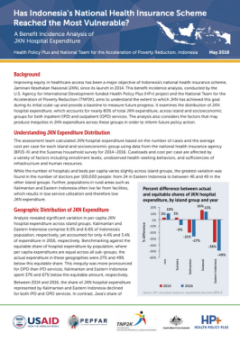
Has Indonesia’s National Health Insurance Scheme Reached the Most Vulnerabl…
Improving equity in healthcare access has been a major objective of Indonesia’s national health insurance scheme, Jaminan Kesehatan Nasional (JKN), since its launch in 2014. This benefit incidence analysis, conducted by the U.S. Agency for International Development-funded Health Policy Plus (HP+) project and the National Team for the Acceleration of Poverty Reduction (TNP2K), aims to under…
- Edisi
- 1
- ISBN/ISSN
- -
- Deskripsi Fisik
- PDF, 2 Halaman
- Judul Seri
- Policy Brief
- No. Panggil
- 363.8 TNP.H
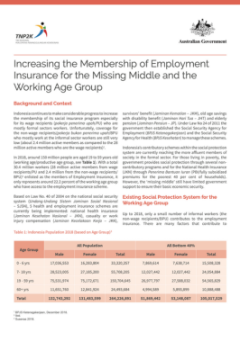
Increasing the Membership of Employment Insurance for the Missing Middle and …
Indonesia continues to make considerable progress to increase the membership of its social insurance program especially for its wage recipients (pekerja penerima upah/PU) who are mostly formal sectors workers. Unfortunately, coverage for the non-wage recipients/pekerja bukan penerima upah/BPU who mostly work at the informal sector workers are still very low (about 2.4 million active members as …
- Edisi
- 1
- ISBN/ISSN
- -
- Deskripsi Fisik
- PDF, 2 Halaman
- Judul Seri
- Policy Brief
- No. Panggil
- 363.3 LAR.I
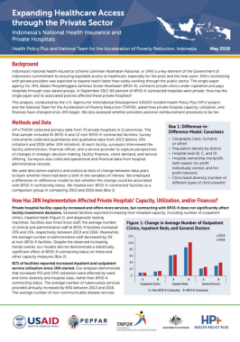
Expanding Healthcare Access through the Private Sector Indonesia’s Nation…
Indonesia’s national health insurance scheme (Jaminan Kesehatan Nasional, or JKN) is a key element of the Government of Indonesia’s commitment to ensuring equitable access to healthcare, especially for the poor and the near-poor. JKN’s contracting with private providers was expected to expand reach faster than solely working through the public sector. The single-payer agency for JKN, B…
- Edisi
- 1
- ISBN/ISSN
- -
- Deskripsi Fisik
- PDF, 2 Halaman
- Judul Seri
- Policy Brief
- No. Panggil
- 368 USA.E
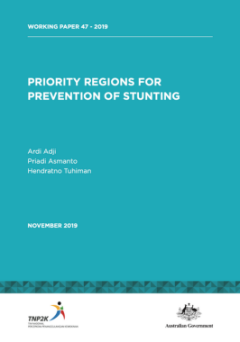
Priority Regions for Prevention of Stunting
One aspect of Indonesia’s health profile that still needs improvement is stunting. In 2018 Indonesia had one of the highest prevalence rates for stunting in the world at 30.8 percent. To achieve the National Medium-Term Development Plan 2015-2019 (Rencana Pembangunan Jangka Menengah Negara: RPJMN) target of a 28 percent stunting rate, in 2018 the government set priority areas for stunting pre…
- Edisi
- Working Paper 47 - 2019
- ISBN/ISSN
- -
- Deskripsi Fisik
- PDF, 28 Halaman
- Judul Seri
- Working Paper
- No. Panggil
- 362.196398 ADJ. P

Harmonisation of Susenas and Riskesdas
To succeed in implementing programs to reduce the number of stunted children, accurate and timely data and information are required to serve as the basis for target and goal setting. The use of Riskesdas (Riset Kesehatan Dasar: Basic Health Research) is highly important to generate indicators on the Indonesian people’s health status and monitor the success of various government programs in th…
- Edisi
- Working Paper 43 - 2019
- ISBN/ISSN
- -
- Deskripsi Fisik
- PDF, 20 Halaman
- Judul Seri
- Working Paper
- No. Panggil
- 362.109598 ADJ. H
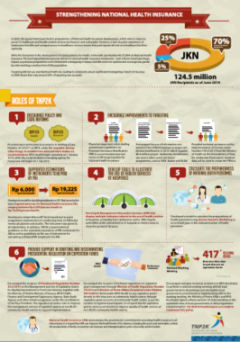
Strengthening National Health Insurance
- Edisi
- -
- ISBN/ISSN
- -
- Deskripsi Fisik
- PDF, 1 Halaman
- Judul Seri
- Info Grafis
- No. Panggil
- 368.3 TNP. S
- Edisi
- -
- ISBN/ISSN
- -
- Deskripsi Fisik
- PDF, 1 Halaman
- Judul Seri
- Info Grafis
- No. Panggil
- 368.3 TNP. S
 Karya Umum
Karya Umum  Filsafat
Filsafat  Agama
Agama  Ilmu-ilmu Sosial
Ilmu-ilmu Sosial  Bahasa
Bahasa  Ilmu-ilmu Murni
Ilmu-ilmu Murni  Ilmu-ilmu Terapan
Ilmu-ilmu Terapan  Kesenian, Hiburan, dan Olahraga
Kesenian, Hiburan, dan Olahraga  Kesusastraan
Kesusastraan  Geografi dan Sejarah
Geografi dan Sejarah